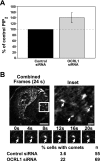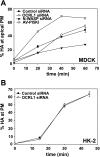OCRL1 function in renal epithelial membrane traffic
- PMID: 19940034
- PMCID: PMC2822509
- DOI: 10.1152/ajprenal.00453.2009
OCRL1 function in renal epithelial membrane traffic
Abstract
The X-linked disorder Lowe syndrome arises from mutations in OCRL1, a lipid phosphatase that hydrolyzes phosphatidylinositol 4,5-bisphosphate (PIP(2)). Most patients with Lowe syndrome develop proteinuria very early in life. PIP(2) dynamics are known to modulate numerous steps in membrane trafficking, and it has been proposed that OCRL1 activity regulates the biogenesis or trafficking of the multiligand receptor megalin. To examine this possibility, we investigated the effects of siRNA-mediated OCRL1 knockdown on biosynthetic and postendocytic membrane traffic in canine and human renal epithelial cells. Cells depleted of OCRL1 did not have significantly elevated levels of cellular PIP(2) but displayed an increase in actin comets, as previously observed in cultured cells derived from Lowe patients. Using assays to independently quantitate the endocytic trafficking of megalin and of megalin ligands, we could observe no defect in the trafficking or function of megalin upon OCRL1 knockdown. Moreover, apical delivery of a newly synthesized marker protein was unaffected. OCRL1 knockdown did result in a significant increase in secretion of the lysosomal hydrolase cathepsin D, consistent with a role for OCRL1 in membrane trafficking between the trans-Golgi network and endosomes. Together, our studies suggest that OCRL1 does not directly modulate endocytosis or postendocytic membrane traffic and that the renal manifestations observed in Lowe syndrome patients are downstream consequences of the loss of OCRL1 function.
Figures






Similar articles
-
The Lowe syndrome protein OCRL1 is required for endocytosis in the zebrafish pronephric tubule.PLoS Genet. 2015 Apr 2;11(4):e1005058. doi: 10.1371/journal.pgen.1005058. eCollection 2015 Apr. PLoS Genet. 2015. PMID: 25838181 Free PMC article.
-
Lowe syndrome protein OCRL1 interacts with clathrin and regulates protein trafficking between endosomes and the trans-Golgi network.Mol Biol Cell. 2005 Aug;16(8):3467-79. doi: 10.1091/mbc.e05-02-0120. Epub 2005 May 25. Mol Biol Cell. 2005. PMID: 15917292 Free PMC article.
-
OCRL1 modulates cilia length in renal epithelial cells.Traffic. 2012 Sep;13(9):1295-305. doi: 10.1111/j.1600-0854.2012.01387.x. Epub 2012 Jul 4. Traffic. 2012. PMID: 22680056 Free PMC article.
-
Role of Ocrl1 in primary cilia assembly.Int Rev Cell Mol Biol. 2015;317:331-47. doi: 10.1016/bs.ircmb.2015.02.003. Epub 2015 Mar 11. Int Rev Cell Mol Biol. 2015. PMID: 26008789 Review.
-
The cellular and physiological functions of the Lowe syndrome protein OCRL1.Traffic. 2014 May;15(5):471-87. doi: 10.1111/tra.12160. Epub 2014 Mar 7. Traffic. 2014. PMID: 24499450 Free PMC article. Review.
Cited by
-
Genetics and phenotypic heterogeneity of Dent disease: the dark side of the moon.Hum Genet. 2021 Mar;140(3):401-421. doi: 10.1007/s00439-020-02219-2. Epub 2020 Aug 29. Hum Genet. 2021. PMID: 32860533 Free PMC article. Review.
-
The fast-recycling receptor Megalin defines the apical recycling pathway of epithelial cells.Nat Commun. 2016 May 16;7:11550. doi: 10.1038/ncomms11550. Nat Commun. 2016. PMID: 27180806 Free PMC article.
-
OCRL1 engages with the F-BAR protein pacsin 2 to promote biogenesis of membrane-trafficking intermediates.Mol Biol Cell. 2016 Jan 1;27(1):90-107. doi: 10.1091/mbc.E15-06-0329. Epub 2015 Oct 28. Mol Biol Cell. 2016. PMID: 26510499 Free PMC article.
-
Effects of Proximal Tubule Shortening on Protein Excretion in a Lowe Syndrome Model.J Am Soc Nephrol. 2020 Jan;31(1):67-83. doi: 10.1681/ASN.2019020125. Epub 2019 Nov 1. J Am Soc Nephrol. 2020. PMID: 31676724 Free PMC article.
-
OCRL localizes to the primary cilium: a new role for cilia in Lowe syndrome.Hum Mol Genet. 2012 Aug 1;21(15):3333-44. doi: 10.1093/hmg/dds163. Epub 2012 Apr 27. Hum Mol Genet. 2012. PMID: 22543976 Free PMC article.
References
-
- Allen PG. Actin filament uncapping localizes to ruffling lamellae and rocketing vesicles. Nat Cell Biol 5: 972–979, 2003 - PubMed
-
- Barbieri MA, Heath CM, Peters EM, Wells A, Davis JN, Stahl PD. Phosphatidylinositol-4-phosphate 5-kinase-1β is essential for epidermal growth factor receptor-mediated endocytosis. J Biol Chem 276: 47212–47216, 2001 - PubMed
-
- Biemesderfer D. Regulated intramembrane proteolysis of megalin: linking urinary protein and gene regulation in proximal tubule? Kidney Int 69: 1717–1721, 2006 - PubMed
-
- Breitfeld PP, Casanova JE, Harris JM, Simister NE, Mostov KE. Expression and analysis of the polymeric immunoglobulin receptor in Madin-Darby canine kidney cells using retroviral vectors. Meth Cell Biol 32: 329–337, 1989 - PubMed
Publication types
MeSH terms
Substances
Grants and funding
LinkOut - more resources
Full Text Sources

